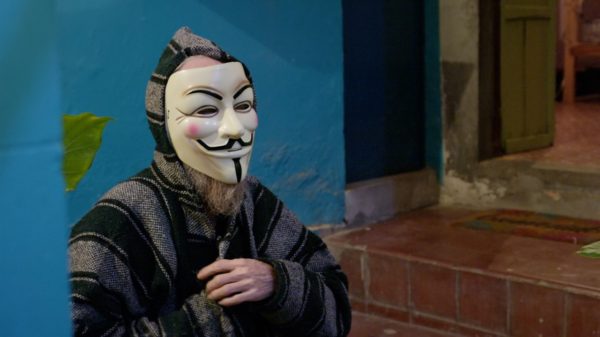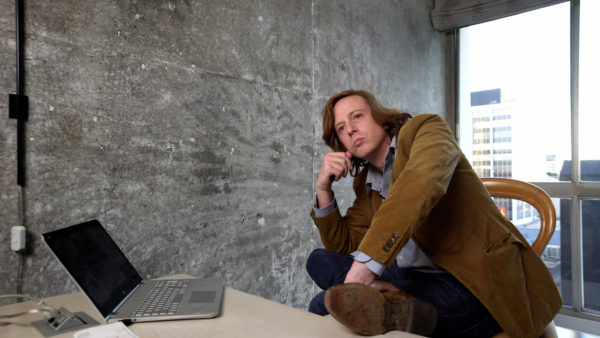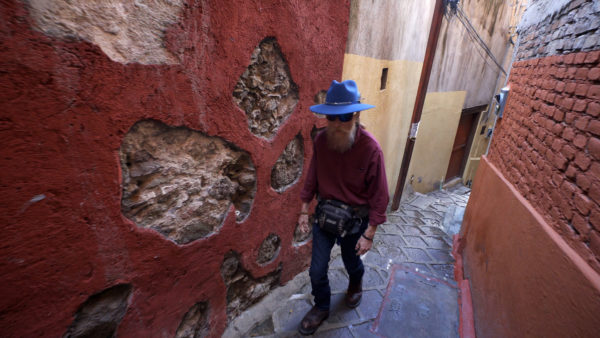
With The Face of Anonymous, writer/director Gary Lang sets out to put a personal face on the purposefully faceless hacker group Anonymous. The face in question is Commander X, aka Christopher Doyon, one of the most visible members of the organization, who often spoke on behalf of the group and even published two books.
The face in question is Commander X, aka Christopher Doyon, one of the most visible members of the organization, who often spoke on behalf of the group and even published two books.
The documentary takes a broad perspective, attempting to paint an intimate portrait of Doyon’s origins as an activist in the 70s, his ascent within several key Anonymous initiatives and his eventual flight from the United States – first to Canada, and then to Mexico, where he has ultimately sought political asylum.
To contextualize this, The Face of Anonymous also documents the genesis of Anonymous, detailing significant moments in the organization’s development such as the Arab Spring and Wikileaks. Other key figures of the group, including founder Gregg Housh and key player Barrett Brown, are accounted for, as well as the former head of the CIA’s cyber crime unit, Leon Panetta.

It’s a tricky balancing act that mostly works, although scope is occasionally an issue: is The Face of Anonymous an intimate portrait of a divisive figure within the group or an exploration of the way that authorities have overstepped in their policing efforts of so-called “cyber terrorists”? There are also occasional detours that detract from the pacing, including a third act storyline involving Brown’s indictment and four year prison sentence, which should act as counterpoint commentary to Doyon’s asylum efforts. Instead it feels disconnected, like a stand-alone B plot that doesn’t really go anywhere.
Arguably the least successful aspect of the documentary are the repeated references to Doyon’s struggles with homelessness. Over the course of the film, Lang interweaves Doyon’s activities within Anonymous with his unstable housing situation. Early on this makes perfect sense: Doyon’s own situation and the Santa Cruz’s “blanket ban” policy targeting the city’s homeless population is a clear motivating factor on Anonymous’ attack on the County Courthouse website. That incident is a kind of galvanizing, inciting incident that propels Doyon’s Citizen X alter-ego into the Anonymous spotlight (and ultimately sets the FBI against him).
Later in the doc when Doyon flees to Canada, however, his life on the street is used to codify him as a fallen figure who requires assistance. This shifts The Face of Anonymous’ story: the more or less objective narrative shifts from painting Doyon as a boastful hacktivist and focuses on him as a vulnerable elderly man who needs the assistance of strangers. This is when novelist Ian Thorton (who opens the documentary) and a variety of hostel owners in Mexico spring into action to assist Doyon with housing, paid opportunities and even travel coordination.

It’s a shift that uncomfortably paints its subject as a pathetic figure. This is cemented by Lang’s inclusion of Doyon’s Million Mask march: the annual global event is typically attended by thousands of Anonymous members, but Doyon’s effort is attended by less than ten people. By contrasting more successful efforts with Doyon’s failure, as well as his reliance on the generosity of others, the implicit take-away is that Doyon is a pitiable “fallen” figure who no longer wields the power that previously brought dictators to their knees.
While The Face of Anonymous does end on an optimistic, slightly hopeful note for Christopher Doyon, the narrative trajectory of his story over the course of the documentary feels strangely judgmental. 3.5/5
The Face of Anonymous is playing at Hot Docs 2021 through May 9. Tickets for the virtual festival can be purchased here.
